Intel Core i7 3960X (Sandy Bridge E) Review: Keeping the High End Alive
by Anand Lal Shimpi on November 14, 2011 3:01 AM EST- Posted in
- CPUs
- Intel
- Core i7
- Sandy Bridge
- Sandy Bridge E
Gaming Performance
Most games have a tough enough time stressing more than four cores, so the move to the 3960X won't do much for gaming in most cases (particularly when GPU bound). That being said, the added cache may help give SNB-E a slight bump over its quad-core brethren.
Civilization V
Civ V's lateGameView benchmark presents us with two separate scores: average frame rate for the entire test as well as a no-render score that only looks at CPU performance.

In GPU bound scenarios the 3960X is no different than the 2600K. Civ V is a unique game in that its CPU workload does scale reasonable well across multiple cores:
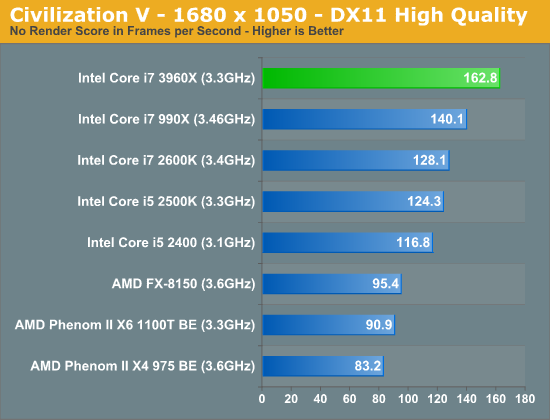
Here the 3960X is nearly 30% faster than the 2600K.
Crysis: Warhead
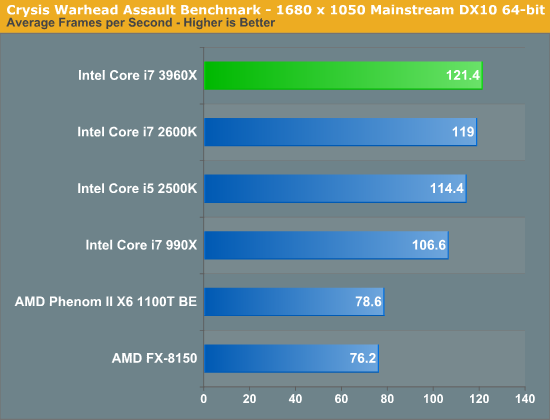
Dawn of War II
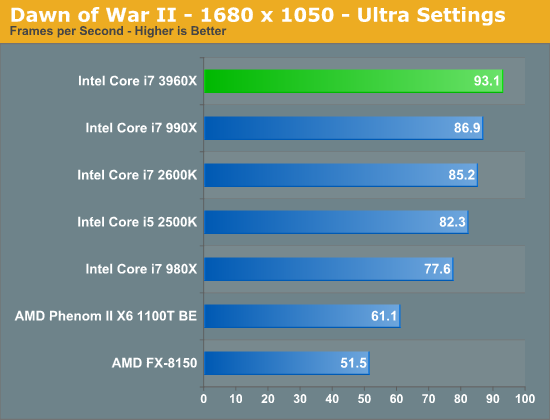
The larger cache helps give the 3960X a 9% advantage over the 2600K in Dawn of War II. At 1680 x 1050 the game isn't entirely GPU bound on our 5870.
DiRT 3
We ran two DiRT 3 benchmarks to get an idea for CPU bound and GPU bound performance. First the CPU bound settings:

DiRT 3 is an example of a CPU bound title (at lower resolutions) that doesn't scale well with core count or cache size. The 3960X is barely 2% faster than the 2600K.
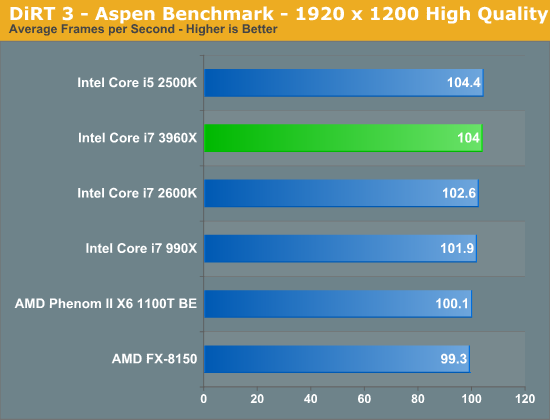
Metro 2033
It is interesting to note that while SNB-E and SNB perform similarly here, both parts do offer a performance improvement over the Gulftown based 990X.
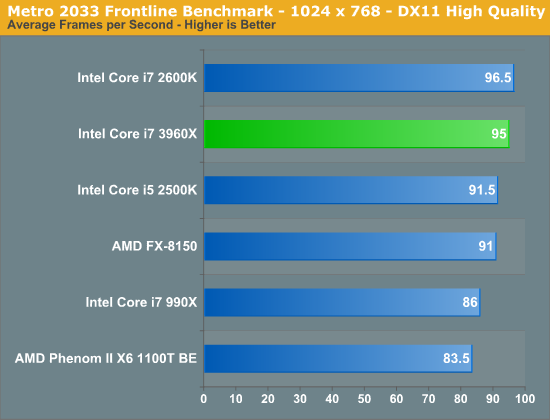
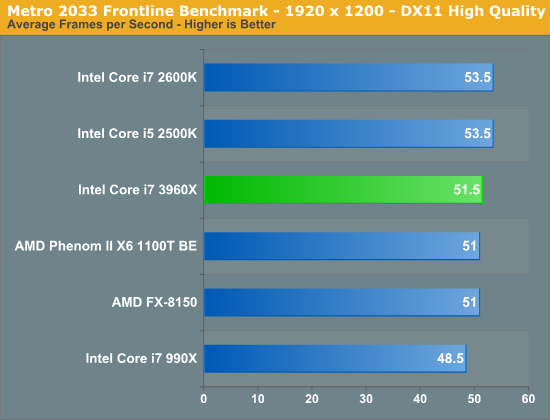
Rage vt_benchmark
While id's long awaited Rage title doesn't exactly have the best benchmarking abilities, there is one unique aspect of the game that we can test: Megatexture. Megatexture works by dynamically taking texture data from disk and constructing texture tiles for the engine to use (note that Rage doesn't store textures in a GPU-usable format). As a result whenever you load a texture, Rage is transcoding the texture on the fly. This is normally done by the CPU.
The Benchmark: vt_ are all the virtual texture commands. Vt_benchmark flushes the texture cache and then times how long it takes to transcode all the textures needed for the current scene, from 1 thread to X threads. Thus when you run vt_benchmark 8, for example, it will benchmark from 1 to 8 threads (the default appears to depend on the CPU you have). Since transcoding is done by the CPU this is a pure CPU benchmark. I present the best case transcode time at the maximum number of concurrent threads each CPU can handle:
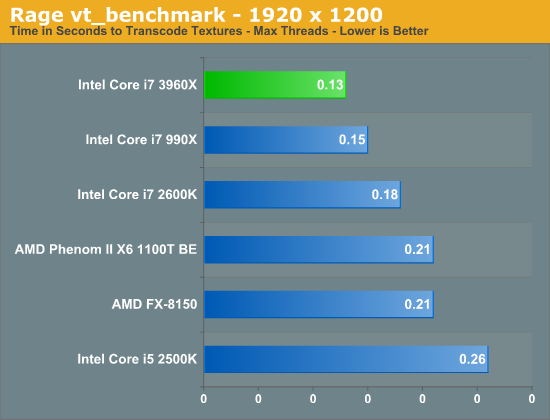
Starcraft 2
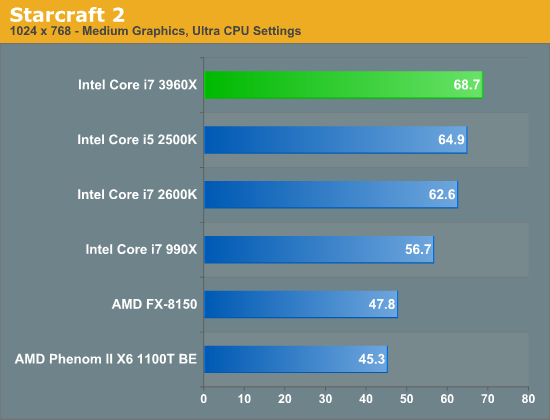
World of Warcraft
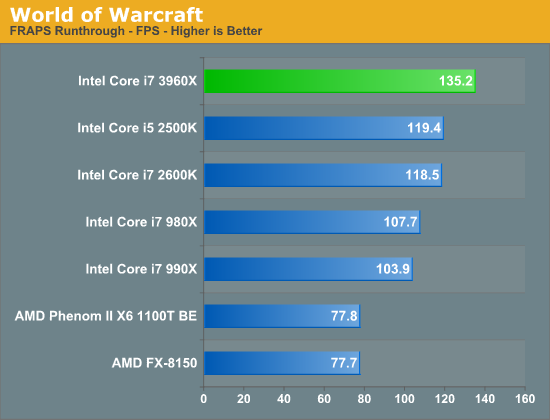
WoW does enjoy the 3960X's larger cache, here we see a 13% increase in performance compared to the regular Sandy Bridge parts.










163 Comments
View All Comments
MOBAJOBG - Monday, November 14, 2011 - link
Thanks for performing the analysis and share those information with us.tenks - Monday, November 14, 2011 - link
Am I the only one disappointed with this review?nad, you usually give some amazing insight beyond the simple #s..In this case talking about whats coming up, if this is worth it compared to upcoming stuff in the pipe, or if the rumors about a respin with fixed features, or an allusion to IVy..etc etc etc..?
You've done it in the past. Are you just not allowed to touch on any of this per Intel?
It was a very vanilla review and I dont mean any disrespect, but thats not why I come here for.
Anand Lal Shimpi - Monday, November 14, 2011 - link
I appreciate the criticism. There are a bunch of things I wanted to do that I simply ran out of time for. I added another couple of paragraphs at the end of the conclusion, hopefully directly addressing your concern.To answer you here though: we may see a new chipset offering next year, but IVB-E will probably be at least a year out from now (perhaps even longer). If you need the core count, you will probably be fine on SNB-E while the rest of the world moves to quad-core IVB in the middle of next year.
Take care,
Anand
tenks - Monday, November 14, 2011 - link
Thanks for the response and updating the review..really cool of you. I didn't mean to come off not appreciative, because I am. Just a long time reader who loves the extra insight, reading between the lines and the dot connecting that you do so well...But the more I think about it, maybe it's just the platform itself that I'm disappointed with? Maybe there is no insight really to be had..There is no real "juice" or cool new info we didn't already know about. I guess with all the silence on the platform, even at IDF, I was hoping for that "And one more thing.." feature in SB-E that we didn't know about..Also, forgive me but I have to try..I know you know something..When well the new stepping and 8-core DESKTOP (EE) skus hit?
THizzle7XU - Monday, November 14, 2011 - link
Will there be a video review for this given the time? Your video reviews have been awesome and I really enjoy the conversation type of setting you present. Don't let anyone complain that they are too long :)Also, I was looking forward to this release, but in the last week I've decided to hold off for a while and see what happens with Ivy Bridge. My alternative upgrade ended up being a 512 GB Crucial M4 for my SATA 3 Sandy Bridge laptop and basically had a trickle down effect with moving my Intel 320 SSD to my Core 2 Quad desktop, desktop Intel G2 SSD to PS3, etc. I felt that was a better way to spend $700-$800 at this point for an upgrade that benefited all my devices instead of just my desktop. With the 22 nm process, it there any chance that the mainstream Ivy Bridge will see a 6-core chip? I thought I read some speculation on that...
yankeeDDL - Monday, November 14, 2011 - link
Call me cynical, but reading this review I couldn't help but thinking about AMD Bulldozer's fail.Would we have the 3960X priced $999, if the FX8150 had been able to deliver decent performance (meaning, an 8-core chip beating the i7 2600 by " a little", at $250)?
And the X79 looks just sloppy.
I'm afraid we're starting to see the effect of poor execution by AMD ...
velis - Monday, November 14, 2011 - link
Yep, agree 100%.The chipset released is - as Anand said - a rebrand of existing one. There is absolutely no reason at all to not include SATA 3 and USB 3 all across except if all budget for development was cut.
And the CPU is actually a step back from existing Sandy bridge offerings. No, that was an understatement - it's just a binned existing offering.
Next I'm expecting Ivy delay into late next year at best unless AMD gets its act together.
JlHADJOE - Monday, November 14, 2011 - link
Yes of course it will still be priced at $999.Maybe the 2500k and 2600k will drop in price a bit if Bulldozer had been more competitive, but Intel's Extreme Edition chips have always been pegged at $999.
Lest you forget, it was actually AMD's heydey that drove CPU prices up to the insane levels we are seeing today. Prior to Athlon's dominance, Intel's highest end chip during the Pentium II days, the PII-450 cost around $600.
AMD went on to dominate the chip space after they stuck with their excellent Athlon line, and Intel floundered with the Presshot. Intel was being dominated badly but managed to compete on price. It was AMD who first announced the $1100+ Athlon FX, forcing Intel to re-socket the Gallatin Xeon and sell it as the Pentium 4 Extreme Edition, just undercutting the Athlon FX's price by selling it at $999.
If you look at Intel's track record while they have the performance lead, they have actually been very reasonable with pricing. Recall the $200 Celeron 300A, for instance, which was pretty good at stock, and would overclock into a PII-450 destroyer. Just recently they introduced the brilliant Sandy Bridge, again at about $200-$250, despite the fact that the 2600k destroys their $999 980/990x in gaming.
It was when AMD had the performance lead that the $1000 CPU segment was established,one that has, for better or worse, persisted to this day (despite intel being currently the sole occupant of that segment space).
yankeeDDL - Monday, November 14, 2011 - link
Respectfully, I disagree.First of all, let me be clear: I am not rooting for AMD dominance: I am rooting for "competition" dominance. AMD jacked prices higher when teh Athlon was ridiculizing the P4, and would do so again -I'm sure- if it had the chance.
But it should be recognized that Intel is doing it now. It has "the power" to do so, but that doesn't make it any better for consumers.
Who "started" with the $1000-segment, frankly, is irrelevant: clearly Intel is enjoying it now, so let's focus on that, shall we?
And yes, Intel's top-of the line has always been $999 for a while, however, it is pretty clear that the 3960X is only marginally better than the much more reasonably priced 3930. I don't recall such huge drop in performance/price ratio ever before (I don't have data, but it strikes me as a particularly bad ROI for the 3960).
This said, the X79 is no excuse: re-branding is despicable, no matter who does it.
Also, I think that if the FX8150 was half teh CPU it was supposed to be, instead of the half-ass that it is, Intel would/should have come out with a better improvement over the existing offer, than the 3960 is.
They have delayed SB-E already by a bit, clearly, indicating that not always worked as they planned. If they had to provide an answer to AMD's "compelling" solution, I am sure they would have cranked up SB-E to be a more evident step forward over SB. But given Bulldozer's lack of performance, why bother? They could come out with SB-E "as-is" and not worry about the performance crown, no worry about the ROI, and no worry about cutting features.
just4U - Monday, November 14, 2011 - link
In my opinion, looking at these results Amd's FX8150 isn't so much of a fail after all. Sure it doesn't compare to this beast but they both seem to shine in multi threaded apps and don't seem to be geared up for desktop users. I was expecting to be blown away with the numbers here.... I am not.